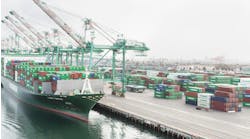Is Supply Chain Slipping Off of the C-Suite Priority List?
Download this article in PDF format.
All eyes were on the world’s supply chains during the global pandemic, when the very concept of taking goods from the point of raw materials to the end-user came under unprecedented scrutiny. Suddenly even individual consumers were conversing about supply chain disruptions, shortages and interruptions—all of which were impacting their daily lives on many different levels.
As with any major disruptive event, as the pandemic began to fade in the rearview mirror it took with it the major emphasis on supply chain-related concerns, interruptions and even opportunities. Now, a new EY report reveals that supply chain may be slipping off of the C-suite’s list of top priorities in favor of other concerns and challenges.
The EY 2024 Supply Chain Survey: Bridging the C-Suite Disconnect is based on insights from 347 U.S. supply chain leaders from various industries whose companies have at least $500 million in annual revenue. In it, EY explains how supply chain issues quickly became a top priority on corporate agendas during the pandemic, and how supply chain leadership “rose to the occasion and delivered significant value.”
However, the company’s new survey of C-suite and supply chain executives suggests that, as the worst of the crisis subsides, the sense of urgency around this issue may be giving way to complacency.
“The series of supply chain shocks that started with the pandemic elevated the role of supply chain leaders in the C-suite, but executive teams are increasingly reverting to outdated views of the supply chain as a cost center rather than a growth engine,” said EY’s Ashutosh Dekhne in a press release. “Our research uncovered concerning perception gaps between supply chain and C-suite executives around the value of supply chain, the digital maturity of supply chains and the value of cross-collaboration.”
88% See Supply Chains as Cost Centers
While 90% of supply chain leaders say their CEO “appreciates” the supply chain’s impact on financial performance, most C-suite executives (88%) still view supply chains as cost centers. Although most (78%) supply chain leaders report their organization is back to focusing on supply chain cost management post-pandemic, 88% of supply chain executives say their organization’s supply chain has a vital role in enhancing the customer experience by promptly addressing customer needs (vs. 76% of C-suite).
“This can have implications for how performance is measured and whether supply chain executives have a seat at the table for discussions on growth and financial priorities,” EY points out.
EY also found that supply chain executives are “significantly more likely” than the C-suite to recognize the benefits of breaking down silos and collaborating internally across functions (e.g., planning, procurement, manufacturing, logistics), as well as externally with vendors.
“While supply chain executives are attuned to the operational benefits of collaboration and technology, likely due to their closer involvement with day-to-day supply chain activities, the C-suite prioritizes financial outcomes and strategic objectives,” the company points out, noting that the C-suite expects such collaboration to be taking place at an operational level.
“Although every company possesses a unique culture and leadership style, disconnects can be substantial enough to hinder supply chain performance, diminish the morale and motivation of supply chain teams, and restrict the strategic use of the supply chain to enhance revenue growth and elevate customer satisfaction,” EY adds.
Turning Attention to the Customer
Right now, EY says 84% of supply chain leaders are more focused on internal operations than customer needs, with 76% indicating they prioritize making new and innovative products over creating the best customer experience.
“In fact, only 44% of supply chain leaders report tracking customer satisfaction (e.g., net promoter score or similar metric) as a supply chain KPI,” says EY, which adds that this may account for some of the disconnect between the C-suite—which often tracks customer satisfaction and loyalty to help determine bottom-line performance—and supply chain leaders.
“There is an opportunity to elevate the way the supply chain is measured by including customer satisfaction (possibly including net promoter score), order fill rate/on time in full, delivery time
or complaint resolution time for tracking integrated supply chain performance,” it says. “Adding customer experience metrics to KPIs provides clear evidence for the supply chain’s impact on growth.”








